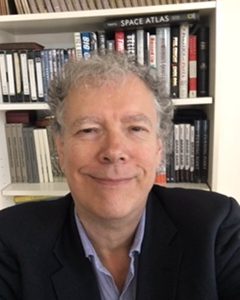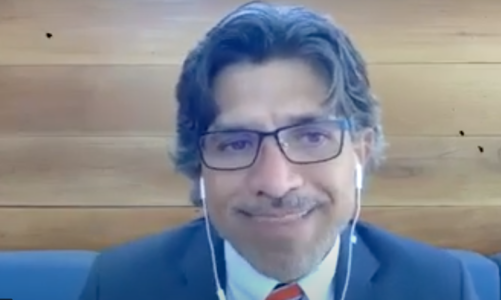
This article is part of Brown University Interview’s Diversity in the Air Force series
Lieutenant Colonel TJ “Doc” Shanks serves as a National Defense Fellow & Visiting Scholar at Brown’s Watson Institute for International and Public Affairs. As an Air Force active-duty officer and command pilot, he has flown more than 3,000 hours and 500 combat hours in the C-17 and C-21 aircraft and participated in combat operations in Afghanistan, Iraq, Syria, and East Africa. He previously served as the Provost of the US Air Force’s Air Mobility Training Center and as Commander of the 97th Training Squadron.
He received his BA in Aviation Management from The Ohio State University, an MA in Unconventional Warfare from American Military University, and holds professional certificates from Saint Louis University and Georgetown University. In 2014, he graduated from the Air Force’s elite Joint Mobility Fellow program, where he authored ground-breaking research into the future use of unmanned and autonomous airlift systems in tactical environments. He is a leading researcher in racial disparity and climate change within the Armed Service.
*05/17/2022 — This article has been updated for typographical and grammatical accuracy.
Autumn Wong: Your work is focused on diversity and climate change within the Air Force. What motivated you to begin that research?
Lieutenant Colonel TJ Shanks: My interest in climate change began during my pilot career as a logistics vulnerability. Every time I deploy, go downrange, or be in a combat zone, there is a person in a fuel truck to come fuel my plane. Without this, I am trapped there with nothing but a handgun. These experiences prompted me to think about energy sources that do not require fossil fuels and their impacts on the greater ecosystem. My wife is also an environmental scientist by training and I can bounce ideas off of her.
The diversity inclusion effort within the Air Force has always been a passion for me as well. I have always been very interested in the institutional dynamics of the Air Force. I remember reading one of the earliest studies that took a serious look into diversity. The report talks about how officers’ careers, especially Black officers, have progressed differently in the ’40s and ’50s. The study essentially concluded that, historically speaking, a lot of the underrepresented minorities were relegated to these support and operational groups.
If you look today, a majority of the underrepresented senior leaders in the Armed Forces are still in the logistics and support arenas. You wonder why we still see these higher proportions in today’s Air Force: it was a legacy piece. It was something as simple as the chain of command pictures on the board when you walk into a building. Ethnically and racially diverse members would walk into a building of an operational unit and would see no one that looks like them. On the other hand, they would go into a supportive logistics unit, and they would see a lot of people who look like them. So, there was this kind of organic draw into these other career fields. It was a sign of unconscious bias, both from an institutional perspective and from the members who think, “I feel like the Armed Forces are communicating to me, so this is where I belong.”
As a Brown University Watson Military Fellow, how does the Watson Institute for International & Public Affairs integrate with your research?
The Watson and the Brown community have been amazing. My research, especially on climate change, is getting to the point where the Air Force is going to want it in the next month or two. There are so many incredible resources at my fingertips. I have started to team up with a few folks in the post-doctorate program here at the Watson Institute.
At the end of my last presentation on climate change, I discussed this kind of “Manhattan Project” for climate change. The climate solutions lab, with Dr. Jeff Colgan and a few of the postdocs, showed interest in actually pursuing this. It is awesome because they are experts in policy and how this gets worked out on Capitol Hill, which is a huge blind spot for me. I can combine my experience in national security and defense affairs with their experience in policy and political affairs. That kind of collaborative effort is so exciting.
When my tenure as a Watson Fellow ends this summer, I’ll be going to the Pentagon. Regardless of what my next job assignment is, I will still be able to plug into that research effort.
What excites you about climate research?
The technology with climate change science. For example, carbon capture technology has been around for a long time. You burn fossil fuels and you can capture the carbon. The problem is once you have a capture, you now have a container of carbon dioxide. Today, a lot of the solutions are dated to the 1950s atomic age. We put it in concrete and place it in the middle of a sink in the ocean. The newest carbon transformation technologies have been emerging. There’s a company called Twelve that recently got Department of Defense (DoD) funding that has created a carbon capture and transformation technology. They capture carbon, combine it with water, use an electrolysis process, and produce hydrogen-based jet fuel.
There’s also AFWERX, the innovation and entrepreneurship arm of the Air Force. AFWERX has developed a satellite-based solar panel array. This is an orbital solar array that can translate that solar energy into a focused directed beam that can collect energy and beam it into a mobile ground station. This technology could be so transformative, and not just from a military perspective. Imagine a village in the middle of nowhere or a disaster area that had its entire power grid cut off. You truck a handful of these things out, and congratulations, you’ve got power. No fuel. No long logistics.
I’m enthusiastic about some of those transformational technologies that I think are going to make a difference. By virtue of being at Brown and plugged into some other places, such as MIT; Harvard; and Stanford, there are these teeny glimmers of new energy sources. Completely sustainable. Completely greenhouse gas-free. Technologies as simple as microreactors and fissionable material. Also, the waste it produces is far less than a traditional nuclear power facility.
As you conduct research in academia, do you still feel a sense of military camaraderie?
The great part about military service is the longer that you’re in, the stronger bonds get. You are often only spending a couple of years in various experiences: pilot training, an operational unit, or time in combat. Regardless of experience, that bond tends to stay there. By virtue of being in the military, everyone usually kind of goes their separate ways. But those bonds, especially with those that stay in the military, are very, very strong.
Furthermore, the longer that you stay, the more people that you meet, and the more likely it is that you all wind up in the same place. In my mobility community, Scott Air Force Base is kind of our nexus. The first time I went to Scott, I was assigned to headquarters. It was like having a reunion. The fun part is that you spend long enough where you know somebody: who they are, their name, and the most intimate details of their family. But, you think, ”I don’t remember when we worked together.”
Keeping in touch professionally through my research or my Air Force work helps. If I have a question for the Air Force folks, I would wonder if I know anybody in that area and look it up. I would find, for example, “One of my really good friends is leading the effort.” It has gotten to an interesting point in my career where I actually know people in different places who can help answer my questions.
When operating within the Air Force, what is the balance between the human touch points when achieving objectives?
I like to think of it actually as synchronization, instead of balance. Hard objectives and human touch will always be balanced depending on what you’re trying to look for. But you can really synchronize to the specific target.
That is the challenge, right? Every big organization has to struggle with synchronizing the human and objective sides. Where I grow concerned, especially from the diversity andinclusion perspective, is when there’s all of one, or all of the other. If it is all objective, that is great, but we are not dealing with humans. We would become what everybody worries about: being just a number in the Air Force. Nobody cares. If it is all human, all the human faults can now play a big factor.
Before the Racial Disparity Review, there were a few of our processes that were almost all human. For example, hiring for important jobs, such as four-star executives. Understandably, this process should lean on the human side because you are dealing with personalities, high-stress environments, etc. But, there was very little quantifiable science. As soon as I saw that, the hairs on the back of my neck stood up.
Maybe I’m just too much of an optimist. I like to lean toward the human side because of the Air Force’s sprawling bureaucratic meritocracy. The system is very well suited for the science piece, as long as it’s included. But there is also the human element. If you ignore the human element, it is going to come out in the quantifiable piece.
You led the effort to change the officer selection process within the Air Mobility community. How have you improved the board selection process to make it more inclusive?
Changing the selection process took a lot of different forms. The mobility sector of the Air Force has twelve to thirteen different boards for various tasks across an entire officer’s career: school selection, promotion, or hiring boards. The first step was really the process analysis, which we wanted to be very, very deliberate about.
First, we created a working group that specifically looks at this issue. We brought in groups of people from diverse backgrounds: professional experiences, ethnicities, races, genders, and careers. Civilians as well. Then we repeated that process for every single kind of quantifiable piece.
It was amazing how many results we received. We discovered that such simple, simple rephrasing could make the process more accessible.
For example, one of our female civilians brought the wording for squadron commander self-nomination policy. The policy stated that if you declined the offer to command after going through the process, you are ineligible to apply next year. You were essentially put in a penalty box. From the moment the application is submitted, to when the wing commander calls, it is a huge six-month process. A lot can happen in someone’s life in six-months. It was just a stroke of the pen to say, “Anyone encountering significant family or life events between application and higher offering can be highlighted. It will be considered by the board president, and will not be considered for retribution.”
When this was brought to our senior leaders, you could see very clearly their intent was to do well. How do we make this better? How do we improve it? Moreover, this was a different journey for every single individual. In the end, every single one of them wanted to make this better and strengthen the organization. So, I was excited to see that nobody “flipped the table” and ran out. Everyone was very interested in how we do this and how we do better.
It is a retention piece too with people staying in the military community. Somebody is feeling like they’re being listened to by the Big Air Force. These are human beings that have human lives. We can take that into account, and people wouldn’t be punished for it.
How do you think people can best eliminate personal bias?
Acceptance is the first step. Understanding the concept of personal bias, and how it can affect decisions.
Then, engage with other people! Do everything you can to try and see things from different perspectives. This can be challenging. But, it is a value that, as a leader, has always been required. Being able to just communicate with people. Knowing that it is not always going to be very comfortable. In fact, if it is uncomfortable, in good ways, that probably means you are making progress.
Just simple day-to-day interactions with your self-awareness and attempt to be aware of others are the biggest things that members can do right now. It is that kind of engagement that makes a big difference. Apathy is so easy, especially with an organization like the Air Force that has been this big, monolithic bureaucracy for so long. It can feel unchangeable. But you can absolutely make a difference. All it takes is will, right? Even if you’re on a huge ship, if every person starts rowing in one direction, you will literally turn on the spot.
What legacy do you want to leave in the Air Force?
With any organization, you always want to make it better. In the twenty years I’ve served so far, it has been really exciting to have seen the extraordinary steps the Air Force has made in so many different areas. I want to effect the organization in a couple of areas.
One area is in terms of shaping leaders, as this will have an enormous effect, positive or negative. It is so easy to engage with a young leader. Talking to them about values and character that I feel are important can help them shape that process. So, from a human level, one of my goals is to shape leaders that are understanding and empathetic, but are still strong enough to make difficult decisions.
At an institutional level, I would want to leave work that can either drive change or that others can use to drive change. Chief of Staff General Charles Q. Brown’s philosophy “accelerate, change or lose” is a powerful rallying call to understand that we must keep changing. Every minute in our nation’s history where we have stopped evolving is where we have come perilously close to disaster. So, that is probably my biggest institutional legacy; I would hope that anything I did would continue to drive that change. This will make us a stronger force.
When the time comes — when I’m done with the Air Force, or the Air Force is done with me — I will be able to say that I have been very, very excited that the legacy will be in the hands of the leaders that I have seen so far.
*This interview has been edited for length and clarity.





Inspiring and insightful. Glad to see such important issues explored through the student lens.